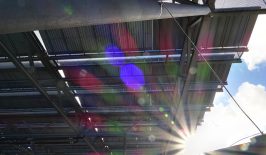A new experimental solar panel is under development which hopes to generate electricity come rain or shine.
With costs dropping by over 90 per cent in recent years, solar power has become a relatively cheap source of electricity, especially in isolated or hard to reach locations. However, solar power is hampered by its inability to efficiently generate electricity in overcast or rainy conditions – although that might be about to change.
Researchers at Soochow University in China have developed a new type of solar panel which can also generate electricity from raindrops – even at night – potentially curing solar power of one of its biggest ailments.
The system utilises two transparent polymer layers which lie on top of the solar photovoltaic (PV) cell used in traditional solar panels. When raindrops hit and flow across the surface, the friction generated leads to a small static electric charge. The surface is also grooved, allowing more light to be reflected into the panel. Similar devices, known as triboelectric nanogenerators (Tengs) have been experimented with in the past, however the Seechow version differs by including a polymer layer that acts as an electrode for both the Teng and the photovoltaic cell, drastically reducing the complexity and cost of the system.
The team does not see their concept ending with simple solar panels. In fact, they have plans to implement the technology in some fairly futuristic ways. Baoquan Sun, of Soochow University, stated in the ACS Nano journal:
“Due to our unique device design, it becomes a lightweight device. In future, we are exploring integrating these into mobile and flexible devices, such as electronic clothes.”
Seechow is not alone in their quest to soup up solar power. Another Chinese research group, Advanced Energy Materials, have begun work on a hybrid panel system that also incorporates wind power in electricity generation. Elsewhere, we have seen small lightweight solar panels also added to other surfaces, such as street pavements or the bricks of buildings.
It is perhaps not surprising Chinese researchers have taken the lead in this area. China is currently undergoing a so-called ‘sun rush’, with the country pouring 132.6bn USD into solar projects in 2017. This is partly in response to quickly growing power demands, but also relates to a recent explosion in use of electric vehicles on the road. If this type of lightweight, multi-faceted power generation system could be applied to vehicles, it could help them generate their own electricity as they drive, be it from sunlight, rain water or wind resistance. Solar panels in the road could also charge vehicles as they pass over them via induction.
Unfortunately, at the moment, the actual amount of electricity developed by these hybrid systems is not enough to justify its use on normal solar panels, let alone space-age electro-fashion or electric cars. Despite this, it is a step in the right direction in making solar panels more attractive as a source of renewable energy, especially in colder, wetter and windier climes.









